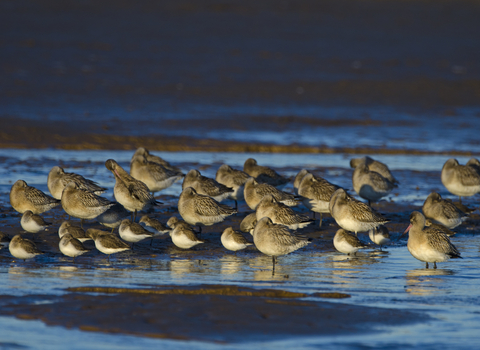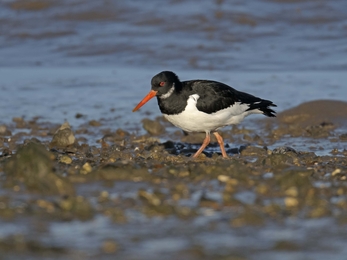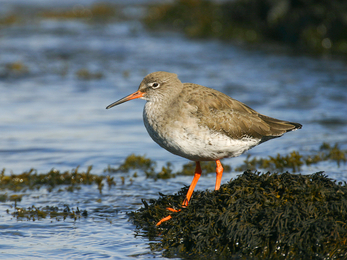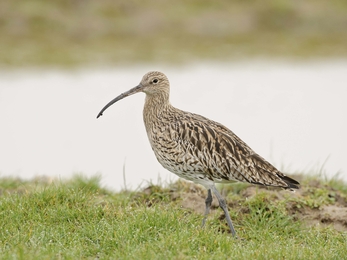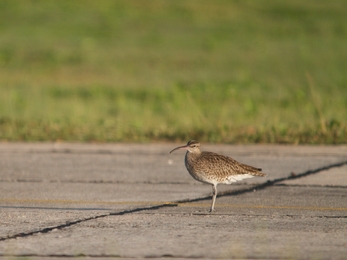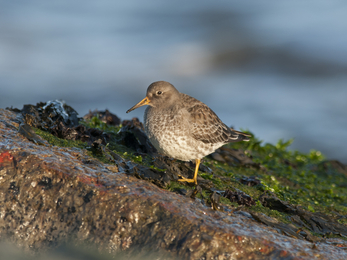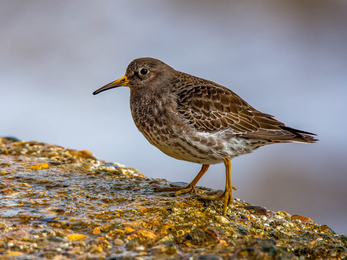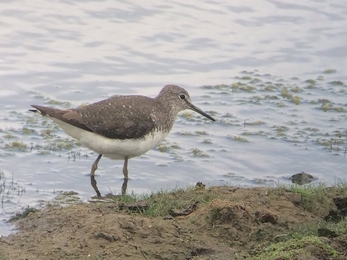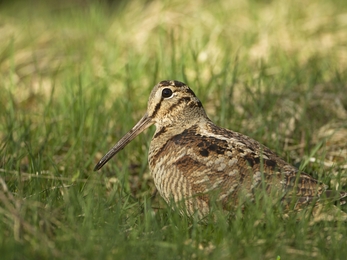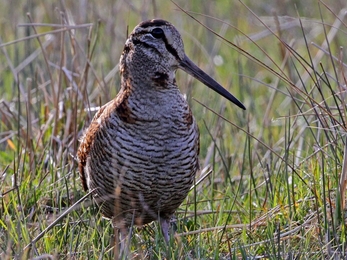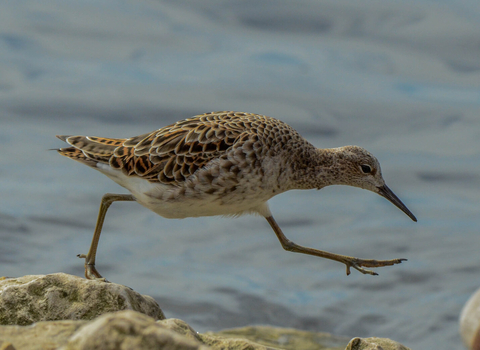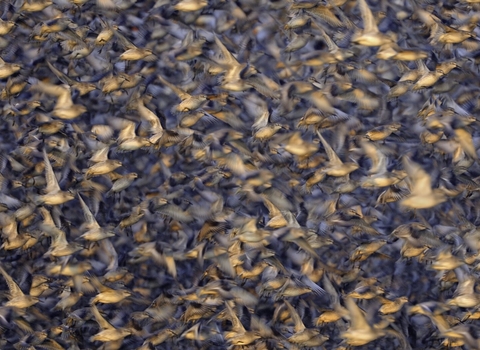What are waders?
Waders can be a tough group to define. The term is used to describe members of a number of bird families, all from the order Charadriiformes (which also includes gulls, terns, skuas, and auks). As the name suggests, most waders are usually found wading through shallow water, or along its muddy margins. They normally have fairly long legs, are often largely brown, and tend to gather in groups. In other parts of the world, they are known as shorebirds.
Which waders am I most likely to see?
Oystercatcher
When & where: All year. Found on coasts throughout the year, with numbers boosted by migrants in winter. Some move inland to nest in spring and summer, when they can often be found on wetlands and fields.
Description: A fairly large, distinctive glossy black-and-white bird, with pink legs and a bright orange-red beak. They also have a red eye with a red ring around it. In winter, they have a white half-collar across the throat. In summer the throat is all black. In flight, they show a broad white bar on each wing and a white rump that extends up the back in a narrow V. They're noisy birds with a loud piping call.
Lapwing
When & where: All year. Common across the UK, on farmland, grasslands, wetlands, and coasts. Found in large flocks in winter.
Description: A pigeon-sized bird. It looks black-and-white at a distance, but up close the back is a beautiful iridescent green with purple hues. It has orange under the tail, a white belly, and a broad black bib across the breast. The throat, forehead, and crown are also black, with a long black crest sticking up from the back of the head. The sides of the face are white, with a thin horizontal black bar across the cheek. It has medium-length pink legs and a short black beak. In flight, the wings are distinctively broad and rounded. Lapwings are active and noisy birds, with an almost electronic call. They're quick to mob potential predators, and in spring they perform tumbling display flights.
Avocet
When & where: All year. In summer they nest on coastal lagoons and increasingly on inland wetlands. Most move to the south coast in winter, where they can be found on sheltered estuaries as well as coastal wetlands.
Description: An elegant bird that's mostly white, with black markings on the wings, the back of the neck, and the crown. They have long, blue-grey legs and a slender black beak that curves upwards.
Golden plover
When & where: All year. In summer, breeds on upland moorlands. In winter, moves to lower ground and forms large flocks on wetlands, farmland, and fields.
Description: A plump bird with black legs and a short dark beak. In summer it has a gold-spangled back, with a black belly that extends up the breast and onto the face. The amount of black varies and some have very little on the face. A band of white separates the black underparts from the golden upperparts, creating a strongly contrasting appearance. In winter, its a more uniform golden brown, with a pale belly. In flight, the base of the underwing is white, which helps separate it from similar species.
Grey plover
When & where: Grey plovers don't breed in the UK, but large numbers spend the winter here or pass through on migration in spring and autumn. They're usually found on coastal mudflats, beaches, and rocky shores, but during migration periods occasionally visit inland wetlands. Some non-breeding birds may be present all summer.
Description: Slightly larger and bulkier than a golden plover, with a heavier beak. The summer breeding plumage is dazzling, with a spangled black and silver back and a black belly, breast and face. It has a white forehead, with the white extending above the eye, down the neck and onto the sides of the breast. Outside of the breeding season, the plumage is brownish-grey, with fine streaking on the breast and a whitish belly. In flight, it reveals black armpits that help identify the species at any time of year.
Ringed plover
When & where: All year. In summer, most nest on shingle and sand beaches, but some will nest at gravel pits or other inland locations. In winter, found in flocks on beaches and mudflats. During spring and autumn migration they often visit inland wetlands.
Description: A small, plump wader with yellow-orange legs. It has a brown back and cap, with white underparts and an obvious white neck collar. A black band separates the white breast from the white throat and collar. There is a black patch on the cheek that extends in a line to the base of the beak. In breeding plumage, the black cheek patch also extends in a band over the forehead, creating a white forehead patch. In winter plumage, the black bib and cheek patch are duller and less extensive, and there is no band over the forehead. The short, stout beak has an orange-base in the breeding season, but can be all dark in winter. Juveniles have a dark beak and duller legs. In flight, there is an obvious white bar on each wing, which helps separate it from the very similar little ringed plover.
Little ringed plover
When & where: March - October. A summer visitor that nests on the pebbly shores of flooded gravel pits and other inland wetlands.
Description: Very similar to the ringed plover, but smaller and more delicate looking, with a slimmer, all dark beak. Adults are easily recognised by the golden ring around the eye. In flight, the wings appear all brown, with at most a very thin white line. They never have the broad white bar shown by ringed plover.
Redshank
When & where: All year. Nests around inland and coastal wetlands, damp meadows, saltmarshes, and moorland. In winter, can be found in a variety of coastal habitats. The wintering numbers are boosted by migrant birds, with some estuaries supporting thousands of redshanks over winter.
Description: A medium-sized wader with bright orange-red legs. It has a straight, medium-length beak with a red base and a dark tip. The upperparts are grey-brown, with a grey-brown wash to the face and breast, and a paler belly. In summer, adults have dense mottling on the underparts. In winter, the mottling is finer and restricted to the breast and flanks. In flight, it has a barred tail, a white wedge up the back, and a broad white bar on the trailing edge of the inner wing. Redshanks are often easily startled or alarmed, causing them to break into a chorus of loud piping calls.
Greenshank
When & where: Throughout the year, with a small breeding population on moorlands in the Highlands and islands of Scotland. Numbers peak in autumn as passage migrants move through, with some return passage in spring. There is also an increasing wintering population. Outside of the breeding season, they're usually found on coastal wetlands, marshes and estuarine creeks. Passage migrants may visit inland wetlands.
Description: A fairly large, often strikingly pale wader. They have long, dull greenish-yellow legs, a long neck, and a thick-based beak that curves upwards slightly. The beak is dark at the tip but dull greenish at the base. In winter they appear very pale, with white underparts, a grey back and grey streaking on the crown and hind neck. In summer they develop dark streaking on the breast and chevron markings on the flanks, and the back becomes a mix of grey feathers and black feathers with white fringes. In flight they show a white 'V' on the back, merging with a white tail with dark barring. They often reveal themselves with a loud "tyu-tyu-tyu" call.
Ruff
When & where: All year. A rare breeding bird in the UK, but common on migration, with some remaining throughout winter.
Description: A very variable bird, both in size and plumage. They're medium sized, though males can be much larger than females. They have a distinctive shape, with a plump body, long neck and small head. The medium-length beak curves down very slightly and can be black or orange. The legs are fairly long and range from greenish to orange. Outside of the breeding season, adults are generally greyish brown on their upperparts, with pale edges to the feathers on the back that give them a scaly look. The underparts are a paler, whitish colour - often greyer on the upper breast and face. Young birds have a peachy-buff head, neck and breast. In the breeding season, most males grow more colourful feathers, including a spectacular ruff that can be white, black, red, or barred brown.
Black-tailed godwit
When & where: All year. A small number of black-tailed godwits nest in the UK, on wet grasslands, but many more come for the winter or stop off on migration. They tend to spend the winter on coastal wetlands, favouring freshwater, but on migration can drop in on inland sites. They form flocks and wade out into belly-deep water to feed.
Description: A large wader with long dark legs and a long beak. The beak is orange or pinkish at the base and darker at the tip. In summer the head, neck and breast are a rusty orange colour. The breast has some dark barring that extends down onto the whiter belly. Males have black feathers on their back, edged with orange-brown, mixed with some plainer grey-brown feathers. Females have more of the grey-brown feathers. Young birds have a buff wash to the neck and breast. In winter, the plumage is a plainer grey-brown. In flight, shows a white square on the rump with a thick black band across the tail, and a white bar across each wing. The feet also stick out a long way past the tail tip.
Bar-tailed godwit
When & where: They don't breed in the UK, but can be seen throuhout the year. Numbers build through autumn and into winter, with birds leaving for breeding grounds throughout spring. Some non-breeding birds may stay in the UK all summer. They gather on coastal mudflats, estuaries, beaches, and brackish wetlands. Migrating birds may occasionally visit inland wetlands.
Description: Very similar to the black-tailed godwit, but with slightly shorter legs and a slightly shorter, more upcurved beak. The beak is all dark in summer but has a pale base in winter (and in young birds). In summer, males are a rich reddish brown from their face down to their undertail, with no barring. Females are less colourful, with an apricot wash to the face and breast, and a paler belly. In winter, both sexes have a pale belly and a sandy brown back with dark streaks on the feathers. The dark streaks, as well as a longer pale line above the eye, help separate them from black-tailed godwits in winter. In flight, it shows a strongly barred tail, a white wedge extending up the back, and no white wing bars. The toes barely stick out beyond the tail.
Curlew
When & where: All year. Nests in a variety of habitats, particularly moorlands, bogs, farmland and wet grassland. In winter, large flocks form on coastal mudflats, saltmarshes and nearby fields.
Description: A large, streaky brown bird with long legs and a distinctively long, downcurved beak. In flight they show a broad white wedge extending from the top of the barred tail to the centre of the back. Whimbrels are very similar in appearance, but less commonly seen - see the whimbrel description below for a comparison.
Whimbrel
When & where: Mostly seen passing through the UK on migration in spring and autumn, when they visit estuaries, coastal marshes and sometimes inland wetlands. Autumn visitors may occasionally stay for the winter. Small numbers nest in the far north of Scotland.
Description: A streaky brown bird with a long curving beak; very similar to the curlew, but slightly smaller. The beak is generally shorter than a curlew's, but beak length is variable and some curlews can have very short beaks. However, whilst curlew beaks curve gradually, whimbrel beaks are less evenly downcurved, giving them more of a hook-tipped appearance. When seen well, another distinctive feature is their head pattern, which shows more contrast than a curlew's usually rather plain face. Whimbrels have a dark crown with a distinct pale stripe running down the centre of it, and a dark stripe through the eye. This creates a noticeable pale band above the eye (the supercilium). In flight, whimbrels have slightly darker wings and a more v-shaped white wedge. Whimbrels also have a distinctive flight call, which is a rippling series of whistles.
Dunlin
When & where: All year. Nests on upland grassland and moorland. Numbers increase in autumn, with hundreds of thousands wintering on coastal shores and wetlands. Often found on inland wetlands, too.
Description: Our most commonly seen small wader, a little smaller than a starling. They have relatively short black legs, and a black, slightly downcurved beak that can vary in length. In summer adults have rich red-brown upperparts and a distinctive black belly. In winter they're plain grey-grown on the back and white on the belly. Young birds have black spots on the breast and belly that gradually dissapear.
Sanderling
When & where: A common passage migrant and winter visitor, with a few non-breeding birds staying throughout summer. Usually found in flocks on sandy beaches, feeding along the water's edge. Migrating birds may occasionally turn up on inland wetlands.
Description: A small wader with short black legs and a short, straight black beak. In winter they are extremely pale, with white underparts and pale grey upperparts. In summer, the back becomes black and reddish-brown with white fringes to the feathers. The head, neck and breast become a rich chestnut colour. With very good views, you can see their most distinctive features - the lack of a hind toe!
In flight they show dark flight feathers that contrast strongly with their grey inner wing and back, and a bold white wing bar that broadens towards the end of the wing. On the ground sanderlings move like clockwork toys, often stopping and starting as they dash in and out with the incoming waves.
Knot
When & where: A passage migrant in spring and autumn, with large numbers also spending the winter on our coasts. Favours mudflats and sandy shores. Flocks of thousands can be found on some major estuaries, such as the Wash. Single birds or small groups may sometimes be seen at inland wetlands on migration.
Description: A medium-sized, distinctly plump wader that is larger and stockier than a dunlin. They have a fairly short, straight black beak and short legs that are greyish-green in winter but darker in summer. Their winter plumage is grey on the back and white below, with grey markings on the breast and flanks. In summer plumage they become a bright brick red from their face to their belly, whilst their back becomes blacker with rusty red patches.
Turnstone
When & where: A widespread passage migrant and winter visitor to coasts around most of the UK. A few non-breeding birds may remain over summer. They're usually found on beaches, where they forage along the strandline or around groynes, piers and other structures. They can even be found in some coastal towns. Migrants may occasionaly appear on inland wetlands.
Description: A stocky, medium-sized wader with short orange legs and a short, dark wedge-shaped beak. In winter they have a greyish-brown back and head, with a white belly and throat separated by a thick blackish breast band that rises in the middle to form a half collar. In summer they show much more contrast, with their back becoming a rich reddish-brown with black bands. The head and neck sides turn largely white, with the breast band becoming black and extending up onto the face in an intricate pattern. In flight they show lots of white markings, including white wingbars, uppertail, and back,
Purple sandpiper
When & where: Mainly a winter visitor to certain coasts, particularly in eastern Scotland and northern England where flocks can be found. They favour rocky shores and often feed alongside turnstones. It's very rare for them to turn up on inland wetlands.
Description: A small wader, slightly larger and stockier than a dunlin. They have short, dull orange legs and a short, slightly downcurved beak that is orange at the base and dark at the tip. In winter they're a dark grey on the head, breast and back (which can sometimes show a slight purple sheen), with white underparts that have blotchy grey markings on the flanks. In summer, their back becomes a mosaic of black, chestnut and white and they develop brown markings on their underparts. In flight they appear darker than a dunlin, showing more contrast with the narrow white wing bar and white sides to the uppertail.
Common sandpiper
When & where: Mainly a summer visitor to the UK, where they nest beside upland lakes, lochs and rivers. In spring and autumn, migrants can be seen on all kinds of wetlands across the UK. Small numbers may remain on wetlands throughout winter.
Description: A small brown and white wader with short, dull yellow or greyish legs. They have a slim, straight medium-length bill with a dark tip. The upperparts are brown and the underparts are white, with the white extending up the breast side, around the front of the wing, in a characteristic notch. They often have a crouched posture and a habit of bobbing the rear of their body up and down, which they share with some other sandpipers. They also have a distinctive flickering flight, staying low over the water with their wings bowed downwards.
Green sandpiper
When & where: Most common from late summer through autumn, as migrants birds fuel up on freshwater wetlands, often well inland. Some birds spend the winter here, departing in spring. There is a tiny breeding population in northern Scotland.
Description: A medium sized wader, slightly larger than the similar common sandpiper. They have yellowish-green legs and a straight, medium-length, thin greenish beak with a dark tip. They're a darker bird than the common sandpiper, with a dark greenish-brown back speckled with fine pale spots. The upper breast is greyish-brown, with a sharp distinction between that and the rest of the white underparts. They lack the white notch of a common sandpiper. They also regularly bob their rear end up and down. In flight they appear very dark, with a bright white rump.
Common snipe
When & where: All year. Nests on moorland and wet grassland. Outside of the breeding season, often found on marshes, muddy pools, reedbeds and other wetlands. Numbers increase in winter with the arrival of migrants from Scandinavia and other regions of Europe.
Description: A chunky, medium-sized wader with short yellowish legs and a very long, straight brown bill with a dark tip. The belly is whitish, but the rest of the plumage is an intricate pattern of golden brown mottling, with darker patches and pale streaks along the back. They have excellent camouflage and can easily disappear amongst reeds and grasses. The head is strongly patterned, with a dark crown split down the middle by a golden crown stripe - a useful feature for ruling out the less commonly seen jack snipe, which is also smaller. Breeding snipe have a display flight in which they take to the air and dive, causing their tail feathers to vibrant and produce a bizarre bleating hum - known as drumming.
Woodcock
When & where: All year. Nests in woodland with open areas. Visits damp fields to feed. Numbers increase in winter with the arrival of migrants from Scandinavia and Russia.
Description: A large, bulky wader - bigger than a snipe, with a proportionally larger head. They have short flesh-coloured legs and a long, straight beak that is pinkish at the base and dark at the tip. They have large eyes, which are set far back on the head, and a steep forehead. They have an intricate pattern of brown, black and rufous feathers on their back which helps them blend in perfectly on the forest floor. Their underside has brown barring, and the head has a series of thick dark bars on the crown. Woodcock are mainly nocturnal, relying on their camouflage to spend the day motionless on the floor. In the breeding season, males perform display flights at dusk and dawn. They fly in straight lines, squeaking and grunting - this display is known as roding.

